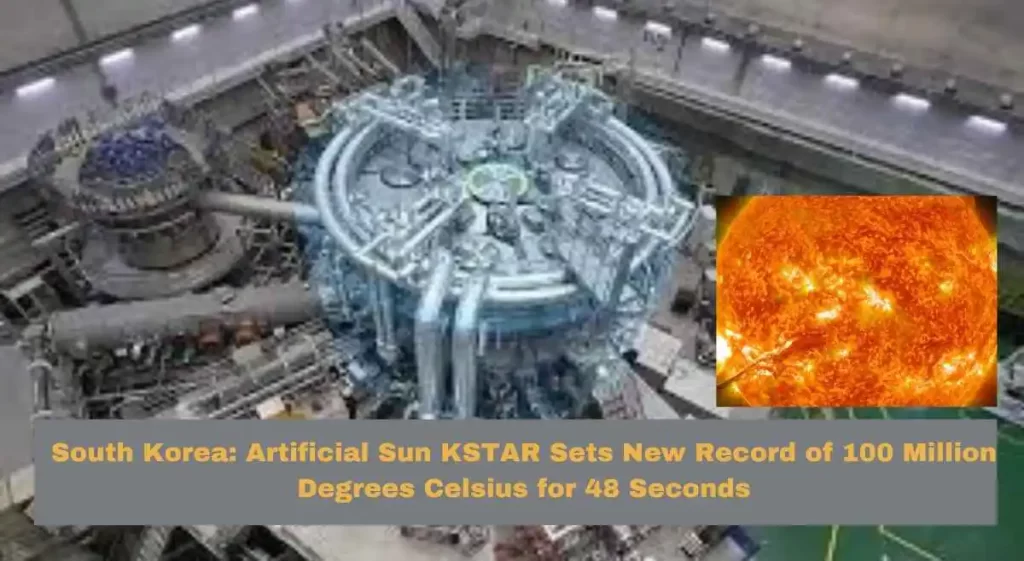Artificial Sun KSTAR :Scientists have made a huge leap forward in creating nuclear fusion energy. They achieved this by creating incredibly high temperatures in a special reactor called an ‘artificial sun.’ This reactor reached a mind-boggling temperature of 100 million degrees Celsius. That’s seven times hotter than the center of the actual sun and a whopping 20,000 times hotter than its surface!

This breakthrough lasted for an impressive 48 seconds, during which a ball of super-hot plasma was maintained. Even more impressive, they were able to keep this super-hot plasma stable for over 100 seconds. This stability is crucial for making nuclear fusion a viable energy source in the future.
South Korea Artificial Sun KSTAR
What is Nuclear Fusion & Why is it Important?
Nuclear fusion involves combining lighter atomic nuclei, typically isotopes of hydrogen, under extreme heat and pressure. This process releases enormous amounts of energy, with minimal waste products compared to traditional nuclear fission. Imagine a virtually endless fuel source (hydrogen readily available in water) and a clean energy solution with minimal environmental impact. That’s the promise of fusion power.
Enter KSTAR: Replicating a Star on Earth
KSTAR is a powerful tokamak, a donut-shaped device that utilizes powerful magnetic fields to confine superheated plasma. Within this magnetic cage, the plasma reaches unimaginable temperatures, mimicking the conditions found in the heart of a star. Read more
Prior to this achievement, KSTAR held the record for maintaining plasma at 100 million degrees Celsius for 20 seconds. This new record nearly doubles that duration, a significant step towards achieving commercially viable fusion power.
Why Does Maintaining High Temperatures Matter?
Fusion reactions only occur when the plasma reaches a specific temperature threshold, known as the ignition point. By sustaining these extreme temperatures for longer periods, scientists can begin to explore methods for extracting energy from the fusion process.
This latest breakthrough brings us closer to that critical threshold, where the energy generated by the fusion reaction surpasses the energy required to sustain it.
Unveiling the “Artificial Sun”: KSTAR and Nuclear Fusion
Nuclear fusion, the process that powers the sun and other stars, holds the key to a clean and sustainable energy future. By combining lighter atomic nuclei under extreme heat and pressure, scientists hope to replicate this stellar energy source on Earth. This process releases enormous amounts of energy with minimal waste products, making it a highly desirable alternative to traditional fossil fuels.
Enter KSTAR, the Korea Superconducting Tokamak Experiment. This powerful machine is aptly nicknamed the “artificial sun” due to the incredible temperatures it can achieve within its core. A tokamak is a donut-shaped device that utilizes powerful magnetic fields to confine superheated plasma, a state of matter where atoms are stripped of their electrons. Within this magnetic cage, the plasma can be heated to unimaginable temperatures, mimicking the conditions found in the heart of a star.
Breaking Records: A New Milestone in Fusion Research
KSTAR held the record for maintaining plasma at a scorching 100 million degrees Celsius for 20 seconds. However, their latest achievement surpasses this mark by a significant margin. The researchers successfully sustained plasma at this incredible temperature for a record-breaking 48 seconds. South Korea Nuclear Fusion Record
This extended duration is a crucial step towards achieving commercially viable fusion power. Fusion reactions only occur when the plasma reaches a specific temperature threshold, known as the ignition point. By maintaining these extreme temperatures for longer periods, scientists can begin to explore methods for extracting energy from the fusion process.
Implications of KSTAR’s Success: KSTAR Sets New Record
The success of the KSTAR team is a major milestone for the field of fusion research. While there’s still a significant journey ahead, this breakthrough paves the way for further advancements, bringing the dream of clean, limitless fusion power closer to reality. Here are some of the exciting implications of this achievement:
- Reduced Dependence on Fossil Fuels: Fusion has the potential to replace fossil fuels as our primary energy source. This would drastically reduce greenhouse gas emissions and mitigate climate change, leading to a cleaner and healthier planet.
- Enhanced Energy Security: With a virtually limitless fuel source (hydrogen isotopes readily available in water), countries would be less reliant on traditional energy sources, fostering greater energy independence.
- Sustainable Energy Future: Fusion offers a clean and sustainable energy solution that can meet the ever-growing global energy demands. The race to achieve commercial fusion power is heating up, with research teams worldwide pushing the boundaries of science. South Korea’s KSTAR has established itself as a frontrunner in this race, and its latest record is a testament to the hard work and dedication of its researchers.
As we reach for the stars, one scorching hot plasma experiment at a time, the future of clean energy is getting brighter.
Frequently Asked Question On South Korea :Artificial Sun
1.What Does 100 Million Degrees Celsius for 48 Seconds Mean for Fusion Power?
South Korea’s KSTAR fusion reactor just achieved a major breakthrough! They successfully sustained scorching hot plasma (100 million degrees Celsius) for nearly a minute, doubling their previous record. This is a crucial step towards achieving fusion power because it brings them closer to the point where the reaction generates more energy than it consumes. While challenges remain, this achievement paves the way for a future powered by clean, limitless fusion energy.
2. Is Fusion Energy the Future? South Korea’s Breakthrough Offers a Glimpse!
Fusion energy, the process that powers stars, might be closer than ever! South Korea’s “artificial sun” just achieved a record-breaking feat, holding plasma at sun-like temperatures for nearly a minute. This breakthrough brings us closer to the holy grail of clean energy: a virtually limitless fuel source with minimal waste. While challenges remain, this is a significant leap towards a future powered by sustainable fusion energy.

Leave a Reply